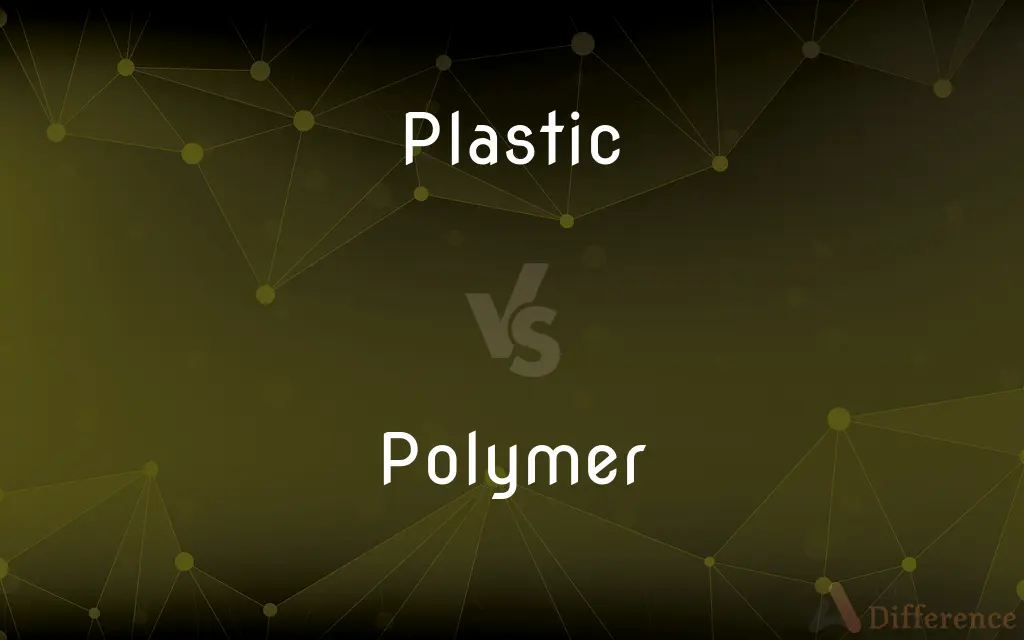Plastic vs. Polymer — What's the Difference?
By Tayyaba Rehman & Fiza Rafique — Updated on April 6, 2024
Plastic is a type of polymer known for its moldability and versatility in manufacturing, whereas polymers are large molecules composed of repeating units, serving as the foundation for plastics and other materials.

Difference Between Plastic and Polymer
Table of Contents
ADVERTISEMENT
Key Differences
Plastics are synthetic or semi-synthetic materials that can be molded into various shapes, thanks to their plasticity. They are primarily made from polymers and often contain additives to enhance their properties. On the other hand, polymers are broad categories of natural or synthetic compounds, characterized by long chains of repeating molecular units called monomers. While plastics are a subset of polymers specifically designed for their durability, flexibility, and moldability, polymers include a wide range of materials, including DNA, proteins, and cellulose, showcasing their fundamental role in both biological and synthetic worlds.
Plastic materials are utilized extensively in daily life, from packaging and household items to automotive and construction applications, highlighting their versatility and adaptability to various manufacturing processes. Polymers, whereas, are not only the building blocks of plastics but also essential components of biological systems and high-tech materials, indicating their ubiquitous presence beyond the realm of plastics. This underlines the diversity of polymers compared to the more application-specific nature of plastics.
The production of plastics involves the polymerization of monomers, often derived from petrochemicals, leading to concerns about sustainability and environmental impact. Conversely, polymers can be sourced from renewable natural resources and biodegradable options, offering a broader spectrum of environmental impacts and solutions. This contrast emphasizes the ecological considerations associated with plastics compared to the broader and potentially more sustainable options within the polymer category.
In terms of physical properties, plastics are engineered to exhibit a wide range of characteristics, including strength, flexibility, and resistance to chemicals and weathering. Polymers, on the other hand, encompass a vast array of physical properties, from the rigid structure of crystalline polymers to the elasticity of rubber, illustrating the fundamental role of polymer science in material engineering and design.
The innovation and development in the field of plastics focus on enhancing material properties, reducing costs, and improving environmental footprints through recycling and bioplastics. Polymer science, however, delves into the discovery and understanding of new materials, exploring applications beyond conventional plastics, including in medicine, energy storage, and nanotechnology. This highlights the broader scientific and technological exploration within polymer science compared to the more focused advancements in plastic materials.
ADVERTISEMENT
Comparison Chart
Definition
A material consisting mainly of polymers, used for its moldability and versatility in products.
Large molecules made up of repeating units, foundational to both natural and synthetic materials.
Origin
Mostly synthetic, derived from petrochemicals.
Both natural (e.g., cellulose, proteins) and synthetic.
Uses
Packaging, household items, automotive parts, etc.
Beyond plastics, includes DNA, proteins, high-tech materials.
Environmental Impact
Often criticized for pollution and recycling challenges.
Broader range, including biodegradable and eco-friendly options.
Material Properties
Designed for specific needs: durability, flexibility, chemical resistance.
Encompasses a wide range of properties, from rigid to elastic.
Compare with Definitions
Plastic
A synthetic material made from a wide range of organic polymers such as polyethylene, PVC, nylon, etc., that can be molded when soft and then hardened for various uses.
Plastic bottles are widely used for beverages because they're lightweight and durable.
Polymer
Synthetic polymers, such as polystyrene, play a crucial role in various industries beyond plastics, including electronics and textiles.
Polystyrene foam is extensively used in packaging for its cushioning properties.
Plastic
Due to their non-degradable nature, plastic products pose significant environmental challenges.
Plastic bags contribute substantially to urban pollution.
Polymer
Natural polymers, including proteins and nucleic acids, are fundamental to biological functions and structures.
DNA, a natural polymer, carries genetic information.
Plastic
Plastics are integral to the development of medical devices, offering sterility and disposability.
Plastic syringes are used once to prevent cross-contamination.
Polymer
Polymers are large molecules composed of many repeated subunits, essential for both synthetic materials like plastics and natural substances.
Cellulose, a polymer, is the main component of plant cell walls.
Plastic
Plastics are known for their versatility in manufacturing and adaptability to various finishes and colors.
Plastic chairs are popular due to their affordability and variety of designs.
Polymer
Research in polymer science aims at developing new materials with unique properties for advanced applications.
Conductive polymers are used in solar cells and electronic devices.
Plastic
Innovative plastics like bioplastics are developed to address environmental concerns, offering better biodegradability.
Bioplastic packaging is becoming more prevalent in the food industry.
Polymer
Biodegradable polymers are gaining attention for reducing the environmental impact of synthetic materials.
Polylactic acid (PLA) is a biodegradable polymer used in compostable plastics.
Plastic
Plastics are a wide range of synthetic or semi-synthetic materials that use polymers as a main ingredient. Their plasticity makes it possible for plastics to be moulded, extruded or pressed into solid objects of various shapes.
Polymer
A polymer (; Greek poly-, "many" + -mer, "part") is a substance or material consisting of very large molecules, or macromolecules, composed of many repeating subunits. Due to their broad spectrum of properties, both synthetic and natural polymers play essential and ubiquitous roles in everyday life.
Plastic
A synthetic material made from a wide range of organic polymers such as polyethylene, PVC, nylon, etc., that can be moulded into shape while soft, and then set into a rigid or slightly elastic form
Mains pipes should be made of plastic or copper
Bottles can be made from a variety of plastics
Polymer
Any of numerous natural and synthetic compounds of usually high molecular weight consisting of up to millions of repeated linked units, each a relatively light and simple molecule.
Plastic
Made of plastic
Plastic bottles
Polymer
(organic chemistry) A long or larger molecule consisting of a chain or network of many repeating units, formed by chemically bonding together many identical or similar small molecules called monomers. A polymer is formed by polymerization, the joining of many monomer molecules.
Plastic
(of a substance or material) easily shaped or moulded
Rendering the material more plastic
Polymer
A material consisting of such polymer molecules.
Plastic
Capable of being shaped or formed
Plastic material such as clay.
Polymer
Any one of two or more substances related to each other by polymerism; specifically, a substance produced from another substance by chemical polymerization.
Plastic
Relating to or dealing with shaping or modeling
The plastic art of sculpture.
Polymer
A naturally occurring or synthetic compound consisting of large molecules made up of a linked series of repeated simple monomers
Plastic
Having the qualities of sculpture; well-formed
"the astonishing plastic beauty of the chorus girls" (Frank Harris).
Plastic
Giving form or shape to a substance
The plastic forces that create and wear down a mountain range.
Plastic
Easily influenced; impressionable
"The plastic mind of the bank clerk had been ... distorted by what he had read" (Rudyard Kipling).
Plastic
Made of a plastic or plastics
A plastic garden hose.
Plastic
(Physics) Capable of undergoing continuous deformation without rupture or relaxation.
Plastic
Capable of building tissue; formative.
Plastic
Able to change and adapt, especially by acquiring alternative pathways for sensory perception or motor skills. Used of the central nervous system.
Plastic
Marked by artificiality or superficiality
A plastic world of fad, hype, and sensation.
Plastic
(Informal) Of or obtained by means of credit cards
Plastic money.
Plastic
Any of various organic compounds produced by polymerization, capable of being molded, extruded, cast into various shapes and films, or drawn into filaments used as textile fibers.
Plastic
(Informal) A credit card or credit cards
Would accept cash or plastic in payment.
Plastic
A synthetic, solid, hydrocarbon-based polymer, whether thermoplastic or thermosetting.
Plastic
Credit or debit cards used in place of cash to buy goods and services.
Plastic
Insincerity; fakeness, or a person who is fake or arrogant, or believes that they are better than the rest of the population.
Plastic
An instance of plastic surgery.
Plastic
(obsolete) A sculptor, moulder.
Plastic
(archaic) Any solid but malleable substance.
Plastic
Capable of being moulded; malleable, flexible, pliant.
Plastic
Producing tissue.
Plastic
(dated) Creative, formative.
Plastic
(biology) Capable of adapting to varying conditions; characterized by environmental adaptability.
Plastic
Of or pertaining to the inelastic, non-brittle, deformation of a material.
Plastic
Made of plastic.
Plastic
Inferior or not the real thing.
Plastic
Fake; insincere.
Plastic
Having the power to give form or fashion to a mass of matter; as, the plastic hand of the Creator.
See plastic Nature working to his end.
Plastic
Capable of being molded, formed, or modeled, as clay or plaster; - used also figuratively; as, the plastic mind of a child.
Plastic
Pertaining or appropriate to, or characteristic of, molding or modeling; produced by, or appearing as if produced by, molding or modeling; - said of sculpture and the kindred arts, in distinction from painting and the graphic arts.
Medallions . . . fraught with the plastic beauty and grace of the palmy days of Italian art.
Plastic
A substance composed predominantly of a synthetic organic high polymer capable of being cast or molded; many varieties of plastic are used to produce articles of commerce (after 1900). [MW10 gives origin of word as 1905]
Plastic
Generic name for certain synthetic or semisynthetic materials that can be molded or extruded into objects or films or filaments or used for making e.g. coatings and adhesives
Plastic
Used of the imagination;
Material...transformed by the plastic power of the imagination
Plastic
Capable of being molded or modeled (especially of earth or clay or other soft material);
Plastic substances such as wax or clay
Plastic
Capable of being influenced or formed;
The plastic minds of children
A pliant nature
Common Curiosities
Are polymers only synthetic?
No, polymers can be both natural, like DNA and proteins, and synthetic, like nylon and polyester.
What makes plastic different from other polymers?
Plastic is a type of polymer designed for its physical properties and ease of manufacturing, whereas polymers include a vast array of natural and synthetic materials with diverse properties and applications.
Can all plastics be recycled?
Not all plastics are easily recyclable due to their composition and the presence of additives, which can complicate the recycling process.
How are plastics made?
Plastics are made through the polymerization of monomers, usually derived from fossil fuels, into long chains that form the plastic material.
Why are plastics harmful to the environment?
Plastics are often non-biodegradable and can accumulate in natural environments, posing threats to wildlife and ecosystems due to pollution and ingestion.
Can polymers conduct electricity?
Some synthetic polymers can be engineered to conduct electricity and are used in applications like organic solar cells and light-emitting diodes (LEDs).
What is bioplastic?
Bioplastics are a type of plastic derived from renewable biomass sources, such as vegetable fats and oils, corn starch, or microbiota, designed to reduce the use of fossil fuel resources and improve biodegradability.
What role do polymers play in nature?
Polymers are essential components of all living organisms, forming structural materials (like cellulose in plants) and functional molecules (like proteins and DNA in animals).
What advancements are being made in polymer science?
Advancements include the development of new polymer structures for improved performance, biodegradability, and applications in technology and medicine.
What is the most common type of plastic?
Polyethylene, particularly in the form of polyethylene terephthalate (PET) and high-density polyethylene (HDPE), is among the most common and widely used plastics.
Are all polymers plastic?
No, while all plastics are polymers, not all polymers are plastics. Polymers include a broad range of materials with different properties and applications beyond plastics.
How does the recycling of plastics work?
Recycling involves collecting and processing plastic waste into new products, often requiring separation by type, cleaning, and remelting of plastic materials.
How are biodegradable polymers different from traditional plastics?
Biodegradable polymers are designed to break down naturally in the environment, offering a more sustainable option compared to traditional, non-degradable plastics.
What is the impact of plastic pollution on oceans?
Plastic pollution in oceans affects marine life through ingestion and entanglement, disrupting ecosystems and potentially entering the human food chain.
Why is polymer research important?
Polymer research is crucial for developing new materials with enhanced properties and applications, including sustainability, medical advancements, and technological innovations.
Share Your Discovery

Previous Comparison
Lift vs. Carry
Next Comparison
Fractionary vs. FractionalAuthor Spotlight
Written by
Tayyaba RehmanTayyaba Rehman is a distinguished writer, currently serving as a primary contributor to askdifference.com. As a researcher in semantics and etymology, Tayyaba's passion for the complexity of languages and their distinctions has found a perfect home on the platform. Tayyaba delves into the intricacies of language, distinguishing between commonly confused words and phrases, thereby providing clarity for readers worldwide.
Co-written by
Fiza RafiqueFiza Rafique is a skilled content writer at AskDifference.com, where she meticulously refines and enhances written pieces. Drawing from her vast editorial expertise, Fiza ensures clarity, accuracy, and precision in every article. Passionate about language, she continually seeks to elevate the quality of content for readers worldwide.














































